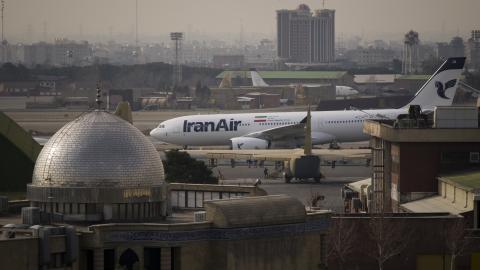On April 13, Iran launched over 300 projectiles at Israel, hoping to overwhelm their air defenses and spill Israeli blood. Thankfully, the attack was thwarted by Israel’s Iron Dome defense system, as well as the aid of allies France, Jordan, the United Kingdom and the United States, who were ultimately responsible for destroying the majority of Iran’s aerial weapons.
Curiously, just days after France and the U.K. helped down airborne Iranian missiles and munitions, Iran Air flights were soaring through the sky as usual, bound for Paris and London.
How can it be that after Iran’s latest aggression, Europe has yet to ban Iran’s national airline from its airspace?
Last week, Sir Liam Fox, a former British defense secretary, bluntly put the question to Prime Minister Rishi Sunak: “Why is Iran Air still operating out of Heathrow?” The same query could be put to the leaders of Austria, France, Germany and Italy, whose nations allow Iran’s national airline to fly direct.
While Iran Air is not the only airline to fly direct routes between Europe and Iran (Lufthansa for instance operates a Frankfurt-Tehran route five times a week), the carrier’s unabashed support for the regime, to say nothing of its symbolism, should lead European policymakers to very seriously consider banning it from free skies.
In the U.S., no direct connections to Iran exist. In fact, it’s been 45 years since Iran Air flew nonstop between Tehran and New York.
Iran Air is currently sanctioned under the U.S. Treasury Department’s Specially Designated Nationals and Blocked Persons List. When the airline was sanctioned by the U.S. in 2011, the U.S. stated it provided “material support and services” to the Iranian Revolutionary Guard.
An element of the 2015 Iran Nuclear Agreement was an easing of restrictions on the sale of aircraft and aircraft components to Iran. Aircraft makers rushed into the breach, inking lucrative contracts to help reconstitute Iran Air’s aging fleet.
In 2018, the Trump administration reversed course and revoked the licenses necessary for aircraft makers to sell to Tehran. Because American components are part of every Western-made plane, the results of the reversal have been substantial.
Iran Air has received only three of the approximately 100 aircraft it ordered from Airbus; the company, not sensing any way back, finally removed the remaining orders from its books earlier this year.
If selling aircraft to Iran remains anathema, why is the country’s national airline retaining the privilege of an air connection to some of Europe’s most important cities?
If the recent Iranian attack against Israel isn’t enough to wake Europe up from its stupor, Iran’s massive support for Russia should be. Iranian ballistic missiles and drones continue to rain death and destruction upon innocent Ukrainians and have helped Moscow better perpetrate a war that will have a determinative effect on Europe’s own security for decades to come.
Iran isn’t merely selling Russia yesterday’s leftovers, but actively seeking to improve the lethality of its birds of prey. A new attack drone created to aid Russia’s war against Ukraine is, according to security sources, “the significant force design work Iran is engaged in to support Russia’s interests regarding Ukraine.”
The devious interchange is a two-way street; Russian know-how has reportedly helped Iran harden its own defenses, with significant implications for the U.S. and its allies.
Last month, European officials in consultation with the Biden administration were said to be mulling a ban on Iran’s national carrier should the country move to supply Russia with ballistic missiles. The reality is that even before its overnight assault on Israel, Iran was already supplying Russia with weapons crucial to Moscow’s war machine, including ballistic missiles.
The answer was obvious then, and it is ever more so now.



















